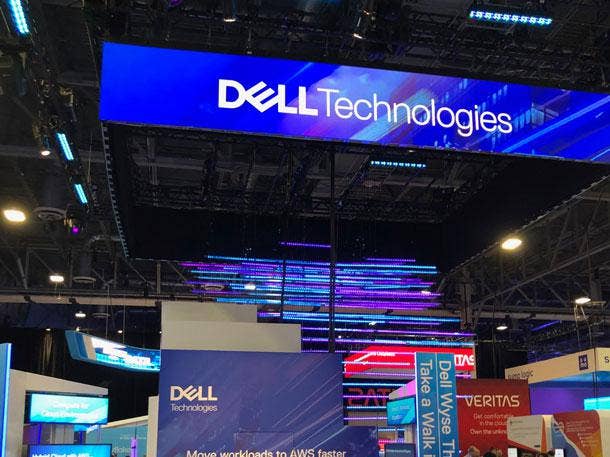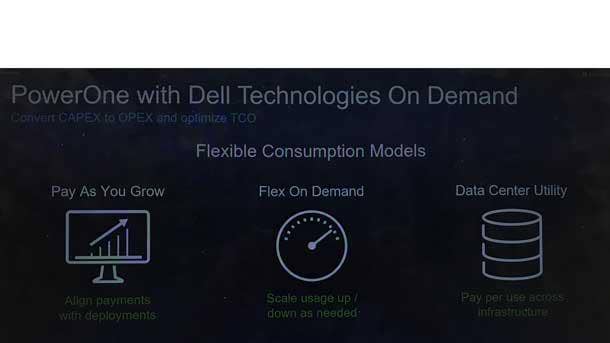Dell Financial Services Execs On New ‘Cash Flow Infusion’ Payment Program
‘The partner doesn’t take the credit risk or the cash flow risk, and we’re financing the entirety of the project inclusive of their mark-up margin. We can quickly infuse them with cash,’ says Darren Fedorowicz, SVP of global partner strategy and operations at Dell Technologies.

New DFS Payment Program To Combat COIVD-19 Disruption
Dell Technologies customers are clamoring for new, creative ways to buy technology while at the same time holding onto their cash to keep business stable during the coronavirus pandemic.
“We’re all living in a different reality now,” said Bill Wavro, president and general manager of Dell Financial Services, in an interview with CRN. “The world has really changed. The one thing that keeps coming out from customers is, ‘Look, we want to keep some cash and we want to continue to make investments in Dell Technologies, but we want to have a more flexible way to blend those.’”
Dell Financing Services (DFS) is stepping up in a major way by rolling out on Tuesday its new Payment Flexibility Program that includes zero-percent interest rates for all server, storage and networking solutions with no up-front payment required as well as deferring first payments up to 180 days on all data center infrastructure and services to help customers manage cash flow.
DFS is also providing brand new short-term options for remote work and learning solutions with six to 12-month terms and refresh options for laptops and desktops. The program includes new one-year term to flexible consumption offerings through its Dell Technologies Flex On Demand program.
Wavro and Darren Fedorowicz, vice president of Dell Financial Services, North American channel and VMware, take a deep dive into the Payment Flexibility Program with CRN.

What are customers and partners saying that made you create the Payment Flexibility Program?
Wavro: Over the last 45 days, the world has changed. We’re all living in a different reality now. We’ve spent a lot of time with customers around, what does our business look like? What does our future look like? How does technology play a role? We’ve seen instances where all-of-a-sudden, customers have an extreme need to add remote working to their portfolio. So things like rollouts of laptops and investments in communications technology that they hadn’t needed before. The world has really changed. The one thing that keeps coming out from customers is, ‘Look, we want to keep some cash and we want to continue to make investments in Dell Technologies, but we want to have a more flexible way to blend those.’ We’ve always been around for that purpose, but for the last 30 days we’ve seen that loud and clear from customers and the partners serving those customers. That’s why we’ve came out with this program. We’ve been evolving this over the last 30 days as we listened to what customers are looking for. Some of them want deferral for three or six months, but some want to go longer than that. They want to do it in a cost-effective way. This program meets both of those needs.

What are some of the brand new offerings to customers and partners in the program?
Wavro: We added on some new options that we hadn’t had in the past which is shorter term leasing. In the past, we tended to stay away from that and do two- or three-year leases. Now we have six-, nine- and 12-month leases. For our Flex on Demand offering – it’s only a year. We used to have it three years. Given everything that’s happened in the world, we want to react and respond in the ways customers are asking us to.
Fedorowicz: Our Flex on Demand program is where customers can purchase and have a baseline commitment level for server, storage, converge infrastructure (CI), hyperconverged infrastructure (HCI), data protection – that may be 50 percent they commit to. Then we monitor their actual usage on a daily basis and charge them on a monthly basis if they go above that base minimum. Those terms were always 36-month to 60-months. But what we hear from customers during this economic uncertainty that’s taking place is, ‘I need infrastructure. I don’t know how much I need and I don’t know how long I need it. I know this isn’t going to be over with immediately.’ The feedback from customers is that they really need something that is a shorter term and commitment than three years. So we’ve now put the Flex on Demand program in place for a 12-month commitment and it applies to everything except servers. So storage, CI, HCI, etc. – a customer commits to a minimum and only a 12-month commitment.

Can you provide an example of how customers can leverage the new 12-month offering from Flex on Demand?
Fedorowicz: As an example, they could have 10-petabytes of storage and they need it today, but they only want to commit to 5-petabytes of storage. It’s a year term, so we’ll measure their usage on a daily basis and charge them on a monthly basis. At the end of 12 months, if they determine they don’t need that anymore, they can return it with no further commitment or they could continue to use it. They have the option to buy it or they can turn it into a longer-term commitment at a much lower price for the next 12-, 24-, or 36- months. So it gives them flexibility both short term in usage flexibility and flexibly at the end of the 12 months in how they want to leverage that infrastructure – if its needed or if it needs to grow. It’s taking all our successful elements of our Dell Technologies Flex On Demand program and just making it shorter term to address these needs.

When does this Payment Flexibility Program expire?
Wavro: It’s going to go through the end of July. If you think about this, it would be easy to make this very short term, but we know there’s going to be an evolution that takes place. So through the end of July seems very reasonable to help and evaluate what’s going on in the market.
Can all tiered-status partners – Gold, Platinum, Titanium -- use the program?
Fedorowicz: Any partner who wants to use this as part of their sales cycle can leverage any of these programs. We’re talking about zero-percent in the deferral, but we also have a 12-month work-from-home solution to help with those short terms needs. Any partner, regardless of their tier, can leverage any of these programs. This program covers all of our end-to-end service countries so U.S., Canada, Mexico – 18 countries in EMEA, in Australia and New Zeeland. It’s global in nature.

Talk about DFS deferring first payments for up to 180 days?
Wavro: Deferrals is kind of the name of the game for us. That’s what we do in a structured way, but this is an additional opportunity to have no payments for 180 days on all those infrastructure and services products. There’s a lot of customers that want that. Nobody knows for sure how long this uncertainty is going to last. We don’t really know, but we’ve had requests from customers across the board looking for those deferrals. We’ve had some 90-day deferrals we’ve run in the past, but we have some customers that want 180 days. We said, ‘Look, for across all those products we’re going to give 180 days and if you add on some of the ISG [Infrastructure Solutions Group] products, then you can get those at zero-percent interest.’ You can double down on both of those for the ISG side. … Really this is around liquidity and cash flow for partners and customers.

How should a partner leverage the 180 defer payment and zero-percent interest?
Fedorowicz: If a customer is looking for something that has a longer first payment deferral, they can couple it where: they can have an infrastructure project that we approve for zero-percent financing and they can have a six month deferral where they would have six months at zero-percent followed by 36 months of payments at zero-percent interest. So that’s over 42 months of paying us back at zero-percent. As soon as the customer agrees to that and the equipment is shipped and installed, we’re immediately paying the partner.
So the partner doesn’t take the credit risk or the cash flow risk, and we’re financing the entirety of the project inclusive of their mark-up margin. We can quickly infuse them with cash. … They may get paid from DFS from within five to ten days. So they have an immediate cash flow infusion. Those are the things that we hear from partners, ‘Not only do my customers have a slowdown, but I need Dell to help us with liquidity and cash flow.’ We’re hearing that on a daily basis. We’re not just helping with zero-percent interest and deferral, but we are making this very real for the partners as well.

Where is Dell Financial Services seeing an influx in demand? Existing or new customers?
Wavro: Both. It’s existing customers some of who have super-solid business models who, suddenly, almost all of their business has shut down or a big piece of the business or it’s changed dramatically. In some cases, demand has grown when you look at places that are selling online where those businesses have a technology need. But where we’re talking to our customer base is around helping them in restructuring payments and deferring existing obligations out there. We’re talking to customers about expansion. For example, suddenly their entire workforce needs to work from home and their not equipped to do that – they need laptops and other needs for working from home and they don’t have the cash or capital to do that.
Then we’re also getting a lot of new customers who maybe haven’t used this financing before. There are companies big and small who are all rotating toward cash. They want to have cash on hand and be able to weather out the storm. They might have not looked at us in the past, but they’re coming at us now because they have an opportunity to use financing and not use cash for technology purchases. We’ve probably never talked to customers more than we’re talking to them today. We’re talking about the ones who need help and the ones who want to use financing to help acquire technology. It’s certainly a very active time for us.